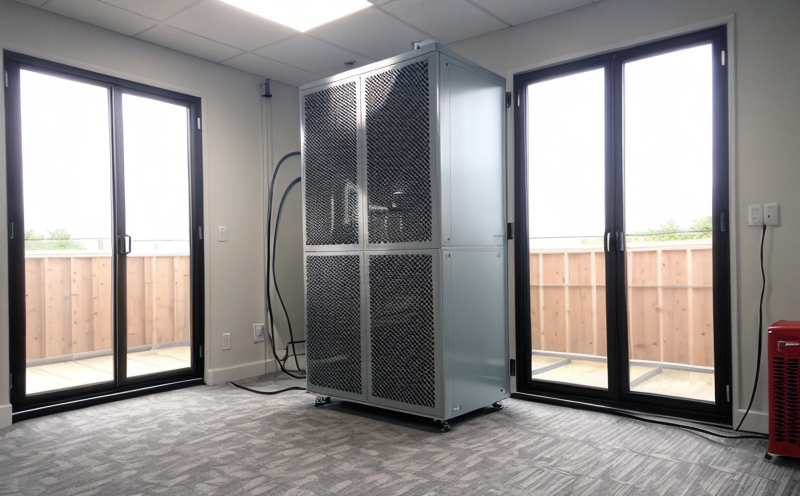EN 12599 Duct Airflow Verification
The EN 12599 standard specifies the methods for the verification of duct airflow in HVAC (Heating, Ventilation, and Air Conditioning) systems. This service ensures that airflows through ducts meet the design specifications, thereby optimizing energy efficiency and ensuring proper ventilation. The test is critical for quality assurance and compliance with local regulations.
The standard covers a range of equipment including supply ducts, return ducts, exhaust ducts, and various types of fans used in HVAC systems. It provides detailed procedures for measuring the airflow at different points within these ducts to verify that they meet the required flow rates specified by the system design or manufacturer.
During testing, we use specialized instruments such as anemometers and Pitot tubes to measure air velocity and calculate total airflow through the ducts. The test setup involves connecting measurement devices directly into the ductwork at specific locations identified in the standard. Once measurements are taken, they are compared against the design specifications or required flow rates.
Accurate verification of duct airflow is essential for several reasons:
- To ensure efficient operation of HVAC systems which can lead to significant energy savings.
- To maintain indoor air quality by ensuring proper ventilation and preventing contamination of airflows in critical environments such as hospitals or data centers.
- To meet regulatory requirements that mandate accurate airflow measurements for compliance with building codes and standards.
The test procedure outlined in EN 12599 is widely recognized across Europe, but it has also gained acceptance globally due to its rigorous methodology. The standard's detailed guidelines ensure that the results are consistent and reliable, making it a preferred choice for HVAC professionals worldwide.
The following table summarizes the key aspects of EN 12599 as they pertain to duct airflow verification:
| Aspect | Description |
|---|---|
| Measurement Points | The standard specifies multiple locations within the ductwork where measurements should be taken, including supply and return ducts. |
| Instrumentation | Pitot tubes, anemometers, and other specialized equipment are used to measure air velocity accurately. |
| Calculation Methodology | Total airflow is calculated based on the measured velocities at specific locations within the ducts. |
| Data Analysis | The data collected is compared against design specifications or required flow rates to determine compliance. |
This service not only helps in ensuring that HVAC systems operate efficiently but also plays a crucial role in maintaining indoor air quality and meeting regulatory requirements. By adhering to EN 12599, we provide clients with reliable data that can be used for continuous improvement of their HVAC systems.
Applied Standards
The primary standard applied in this service is EN 12599. This European standard provides comprehensive guidelines for the verification of duct airflow in HVAC systems. It covers various aspects such as measurement points, instrumentation used, calculation methodologies, and data analysis techniques.
| Standard | Title |
|---|---|
| EN 12599 | Verification of Duct Airflow in HVAC Systems |
The standard is widely recognized and used across Europe, but its rigorous methodology has also gained global acceptance. Compliance with EN 12599 ensures that the results obtained are consistent and reliable, which is crucial for HVAC professionals.
Benefits
Ensures efficient operation of HVAC systems leading to significant energy savings.
Maintains indoor air quality by ensuring proper ventilation and preventing contamination in critical environments.
Meets regulatory requirements, ensuring compliance with building codes and standards.
Provides reliable data that can be used for continuous improvement of HVAC systems.
Safeguards against potential issues such as over- or under-ventilation which could lead to health hazards or increased energy consumption.
Promotes the use of high-quality materials and components in HVAC design, contributing to long-term system performance.
Enhances safety by ensuring that all aspects of the HVAC system operate within specified parameters.
The benefits extend beyond just meeting compliance requirements. By adhering to EN 12599, clients can expect enhanced performance, reduced maintenance costs, and a safer working environment for all occupants of the building.
International Acceptance and Recognition
The EN 12599 standard has gained significant recognition not just within Europe but globally. Many countries have adopted its methodologies into their national standards, recognizing the importance of accurate duct airflow verification for HVAC systems.
In regions where no specific local standard exists, EN 12599 serves as a benchmark for best practices in duct airflow verification. The international acceptance of this standard is evident from its widespread use across various industries including commercial buildings, hospitals, and data centers.
The rigorous methodology provided by the standard ensures consistency in results, which is crucial for HVAC professionals worldwide. This uniformity allows for easier comparison of data between different regions and countries, facilitating better collaboration among professionals involved in HVAC design, installation, and maintenance.
Moreover, compliance with EN 12599 can be a significant advantage when bidding on international contracts or working with multinational clients. It demonstrates a commitment to high-quality standards that are recognized globally, thereby enhancing the reputation of the company providing the service.





